Change Control Report: Analysis of Blue Spider Project Changes
VerifiedAdded on 2022/09/06
|10
|2081
|16
Report
AI Summary
This report provides a comprehensive analysis of change control within the Blue Spider project. It identifies necessary changes, including the implementation of project tracking tools, sensor-based data gathering, and automation of workflow processes. The report details procedures for requesting these changes, such as the use of Process Decision Program Charts (PDPC) and Six Sigma methodologies, while also emphasizing the importance of expert guidance and training. Furthermore, the report evaluates potential risks associated with these technological changes, such as data breaches and communication gaps, and proposes various options to satisfy the technological changes. Ultimately, the report concludes that the Blue Spider project requires significant change management to achieve a successful outcome, highlighting the importance of effective communication, risk mitigation, and automation to improve project efficiency.

Running head: CHANGE CONTROL AT BLUE SPIDER
CHANGE CONTROL AT BLUE SPIDER
Name of the student:
Name of the university:
Author Note:
CHANGE CONTROL AT BLUE SPIDER
Name of the student:
Name of the university:
Author Note:
Paraphrase This Document
Need a fresh take? Get an instant paraphrase of this document with our AI Paraphraser
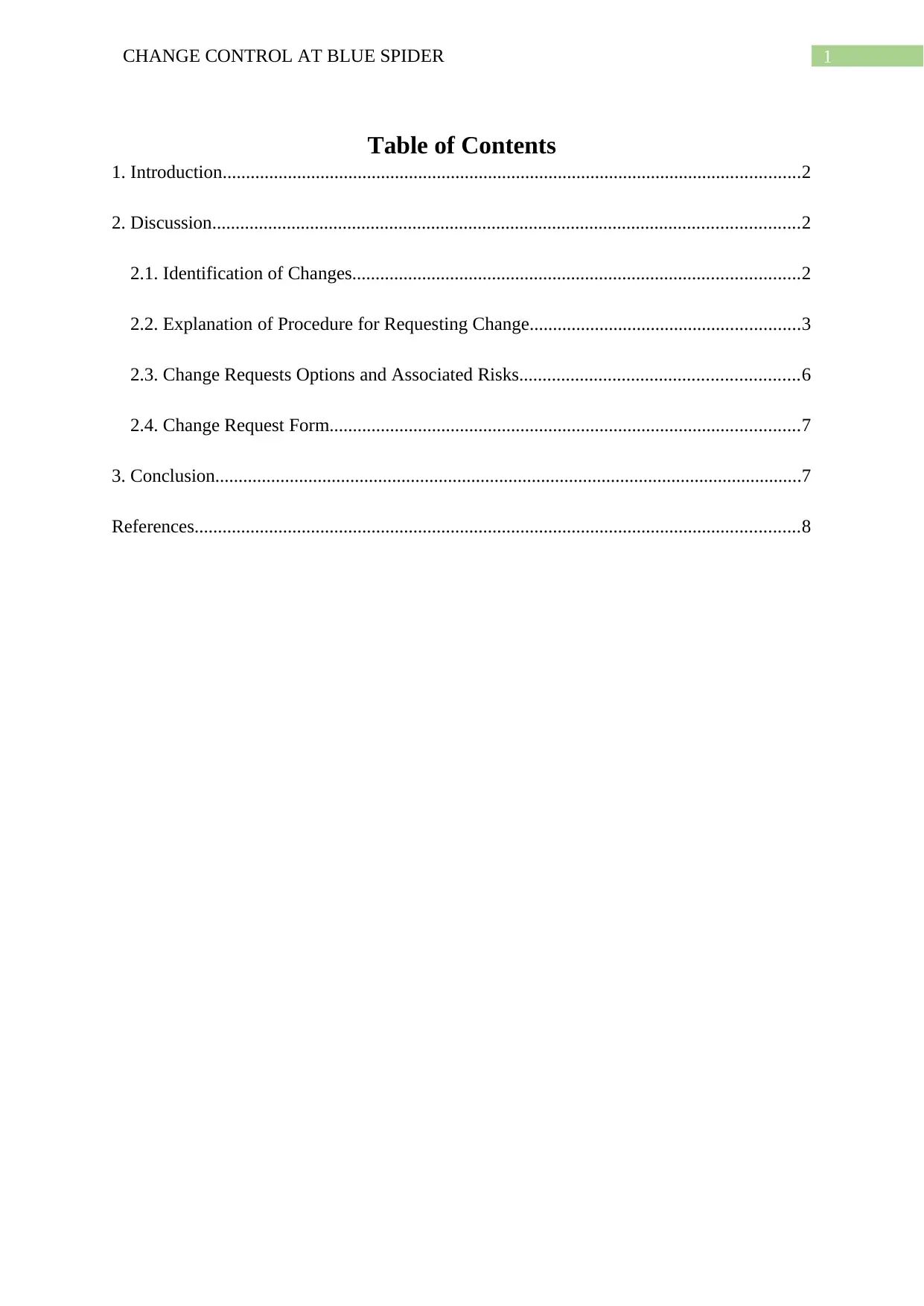
1CHANGE CONTROL AT BLUE SPIDER
Table of Contents
1. Introduction............................................................................................................................2
2. Discussion..............................................................................................................................2
2.1. Identification of Changes................................................................................................2
2.2. Explanation of Procedure for Requesting Change..........................................................3
2.3. Change Requests Options and Associated Risks............................................................6
2.4. Change Request Form.....................................................................................................7
3. Conclusion..............................................................................................................................7
References..................................................................................................................................8
Table of Contents
1. Introduction............................................................................................................................2
2. Discussion..............................................................................................................................2
2.1. Identification of Changes................................................................................................2
2.2. Explanation of Procedure for Requesting Change..........................................................3
2.3. Change Requests Options and Associated Risks............................................................6
2.4. Change Request Form.....................................................................................................7
3. Conclusion..............................................................................................................................7
References..................................................................................................................................8
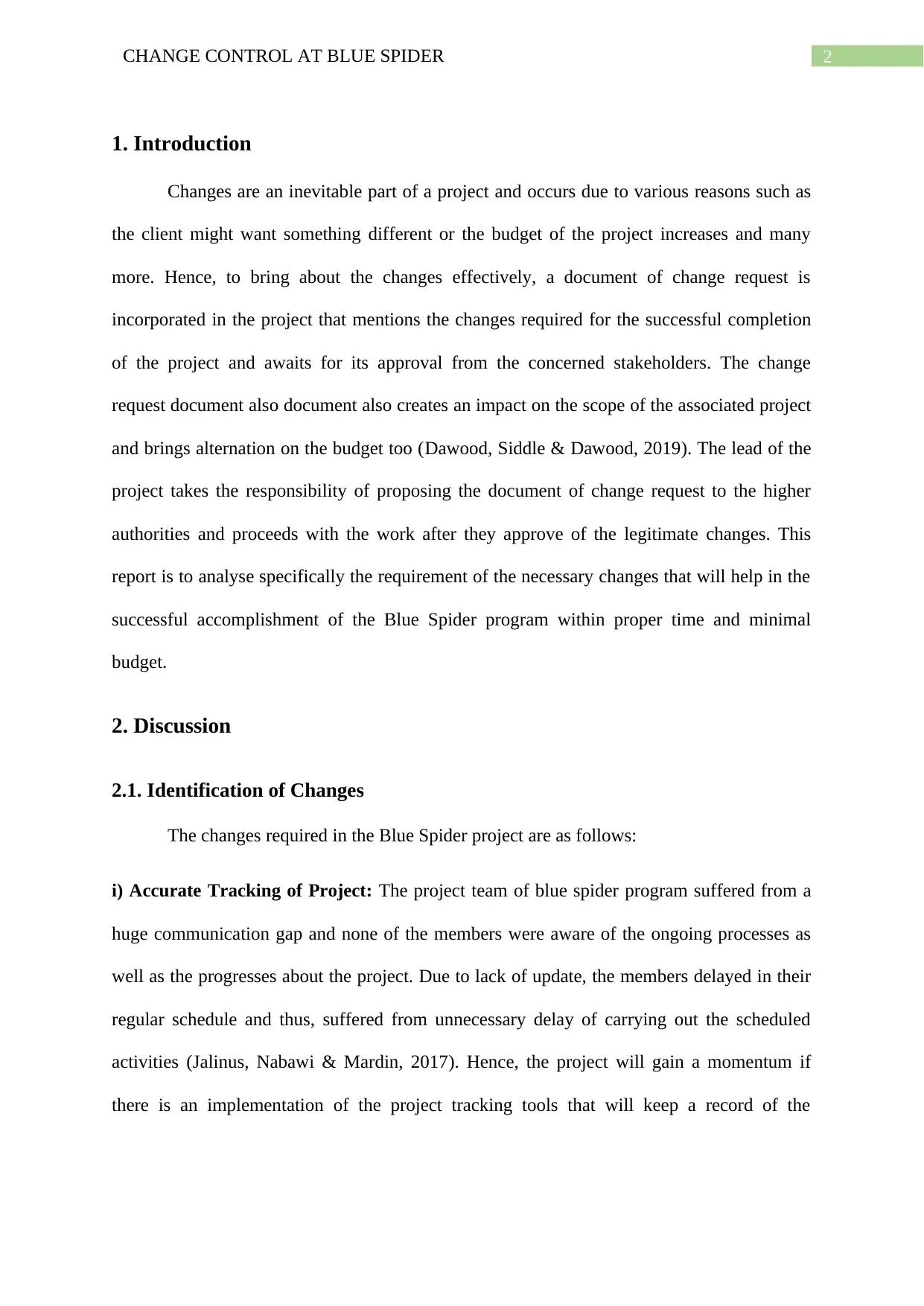
2CHANGE CONTROL AT BLUE SPIDER
1. Introduction
Changes are an inevitable part of a project and occurs due to various reasons such as
the client might want something different or the budget of the project increases and many
more. Hence, to bring about the changes effectively, a document of change request is
incorporated in the project that mentions the changes required for the successful completion
of the project and awaits for its approval from the concerned stakeholders. The change
request document also document also creates an impact on the scope of the associated project
and brings alternation on the budget too (Dawood, Siddle & Dawood, 2019). The lead of the
project takes the responsibility of proposing the document of change request to the higher
authorities and proceeds with the work after they approve of the legitimate changes. This
report is to analyse specifically the requirement of the necessary changes that will help in the
successful accomplishment of the Blue Spider program within proper time and minimal
budget.
2. Discussion
2.1. Identification of Changes
The changes required in the Blue Spider project are as follows:
i) Accurate Tracking of Project: The project team of blue spider program suffered from a
huge communication gap and none of the members were aware of the ongoing processes as
well as the progresses about the project. Due to lack of update, the members delayed in their
regular schedule and thus, suffered from unnecessary delay of carrying out the scheduled
activities (Jalinus, Nabawi & Mardin, 2017). Hence, the project will gain a momentum if
there is an implementation of the project tracking tools that will keep a record of the
1. Introduction
Changes are an inevitable part of a project and occurs due to various reasons such as
the client might want something different or the budget of the project increases and many
more. Hence, to bring about the changes effectively, a document of change request is
incorporated in the project that mentions the changes required for the successful completion
of the project and awaits for its approval from the concerned stakeholders. The change
request document also document also creates an impact on the scope of the associated project
and brings alternation on the budget too (Dawood, Siddle & Dawood, 2019). The lead of the
project takes the responsibility of proposing the document of change request to the higher
authorities and proceeds with the work after they approve of the legitimate changes. This
report is to analyse specifically the requirement of the necessary changes that will help in the
successful accomplishment of the Blue Spider program within proper time and minimal
budget.
2. Discussion
2.1. Identification of Changes
The changes required in the Blue Spider project are as follows:
i) Accurate Tracking of Project: The project team of blue spider program suffered from a
huge communication gap and none of the members were aware of the ongoing processes as
well as the progresses about the project. Due to lack of update, the members delayed in their
regular schedule and thus, suffered from unnecessary delay of carrying out the scheduled
activities (Jalinus, Nabawi & Mardin, 2017). Hence, the project will gain a momentum if
there is an implementation of the project tracking tools that will keep a record of the
⊘ This is a preview!⊘
Do you want full access?
Subscribe today to unlock all pages.

Trusted by 1+ million students worldwide
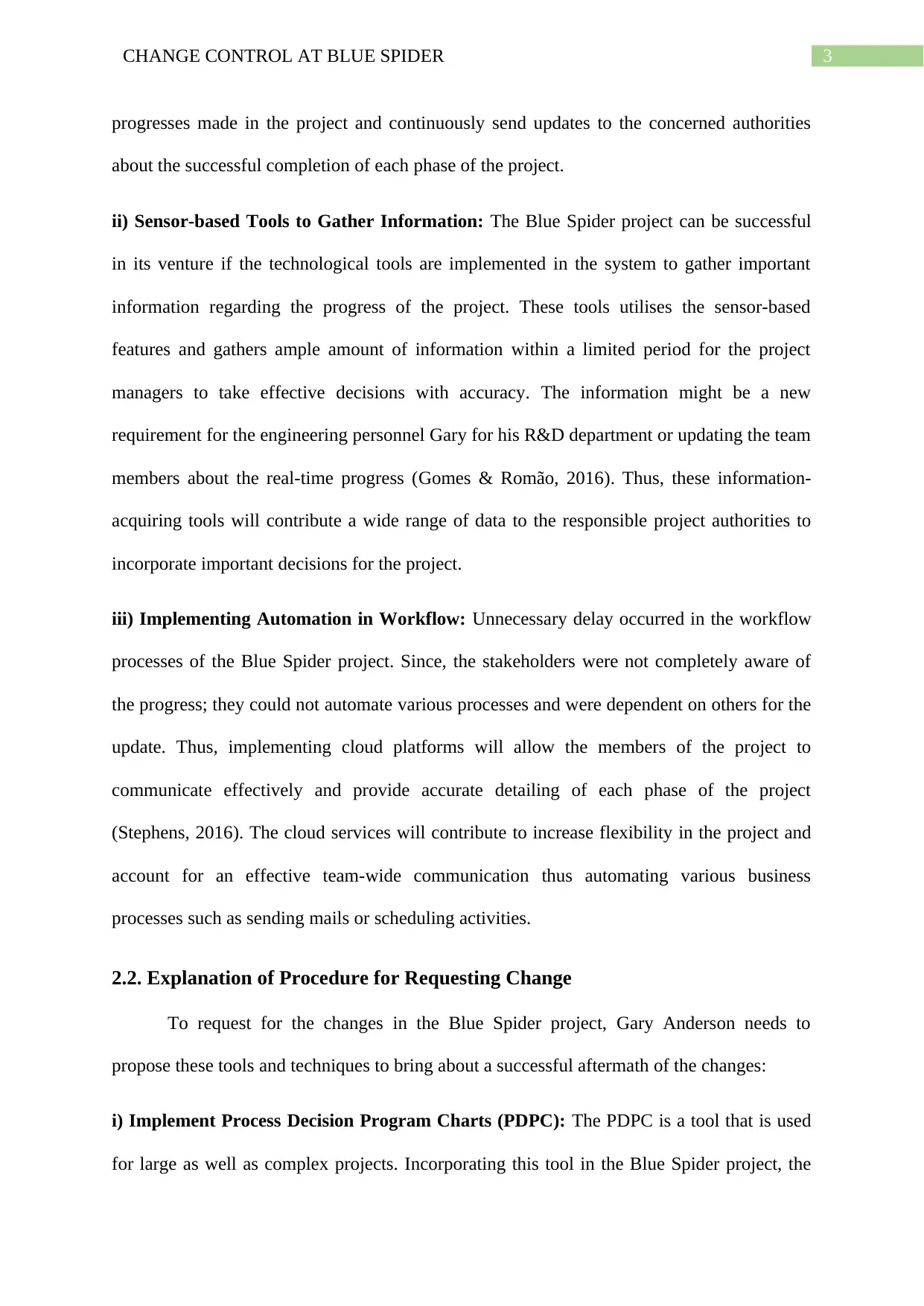
3CHANGE CONTROL AT BLUE SPIDER
progresses made in the project and continuously send updates to the concerned authorities
about the successful completion of each phase of the project.
ii) Sensor-based Tools to Gather Information: The Blue Spider project can be successful
in its venture if the technological tools are implemented in the system to gather important
information regarding the progress of the project. These tools utilises the sensor-based
features and gathers ample amount of information within a limited period for the project
managers to take effective decisions with accuracy. The information might be a new
requirement for the engineering personnel Gary for his R&D department or updating the team
members about the real-time progress (Gomes & Romão, 2016). Thus, these information-
acquiring tools will contribute a wide range of data to the responsible project authorities to
incorporate important decisions for the project.
iii) Implementing Automation in Workflow: Unnecessary delay occurred in the workflow
processes of the Blue Spider project. Since, the stakeholders were not completely aware of
the progress; they could not automate various processes and were dependent on others for the
update. Thus, implementing cloud platforms will allow the members of the project to
communicate effectively and provide accurate detailing of each phase of the project
(Stephens, 2016). The cloud services will contribute to increase flexibility in the project and
account for an effective team-wide communication thus automating various business
processes such as sending mails or scheduling activities.
2.2. Explanation of Procedure for Requesting Change
To request for the changes in the Blue Spider project, Gary Anderson needs to
propose these tools and techniques to bring about a successful aftermath of the changes:
i) Implement Process Decision Program Charts (PDPC): The PDPC is a tool that is used
for large as well as complex projects. Incorporating this tool in the Blue Spider project, the
progresses made in the project and continuously send updates to the concerned authorities
about the successful completion of each phase of the project.
ii) Sensor-based Tools to Gather Information: The Blue Spider project can be successful
in its venture if the technological tools are implemented in the system to gather important
information regarding the progress of the project. These tools utilises the sensor-based
features and gathers ample amount of information within a limited period for the project
managers to take effective decisions with accuracy. The information might be a new
requirement for the engineering personnel Gary for his R&D department or updating the team
members about the real-time progress (Gomes & Romão, 2016). Thus, these information-
acquiring tools will contribute a wide range of data to the responsible project authorities to
incorporate important decisions for the project.
iii) Implementing Automation in Workflow: Unnecessary delay occurred in the workflow
processes of the Blue Spider project. Since, the stakeholders were not completely aware of
the progress; they could not automate various processes and were dependent on others for the
update. Thus, implementing cloud platforms will allow the members of the project to
communicate effectively and provide accurate detailing of each phase of the project
(Stephens, 2016). The cloud services will contribute to increase flexibility in the project and
account for an effective team-wide communication thus automating various business
processes such as sending mails or scheduling activities.
2.2. Explanation of Procedure for Requesting Change
To request for the changes in the Blue Spider project, Gary Anderson needs to
propose these tools and techniques to bring about a successful aftermath of the changes:
i) Implement Process Decision Program Charts (PDPC): The PDPC is a tool that is used
for large as well as complex projects. Incorporating this tool in the Blue Spider project, the
Paraphrase This Document
Need a fresh take? Get an instant paraphrase of this document with our AI Paraphraser
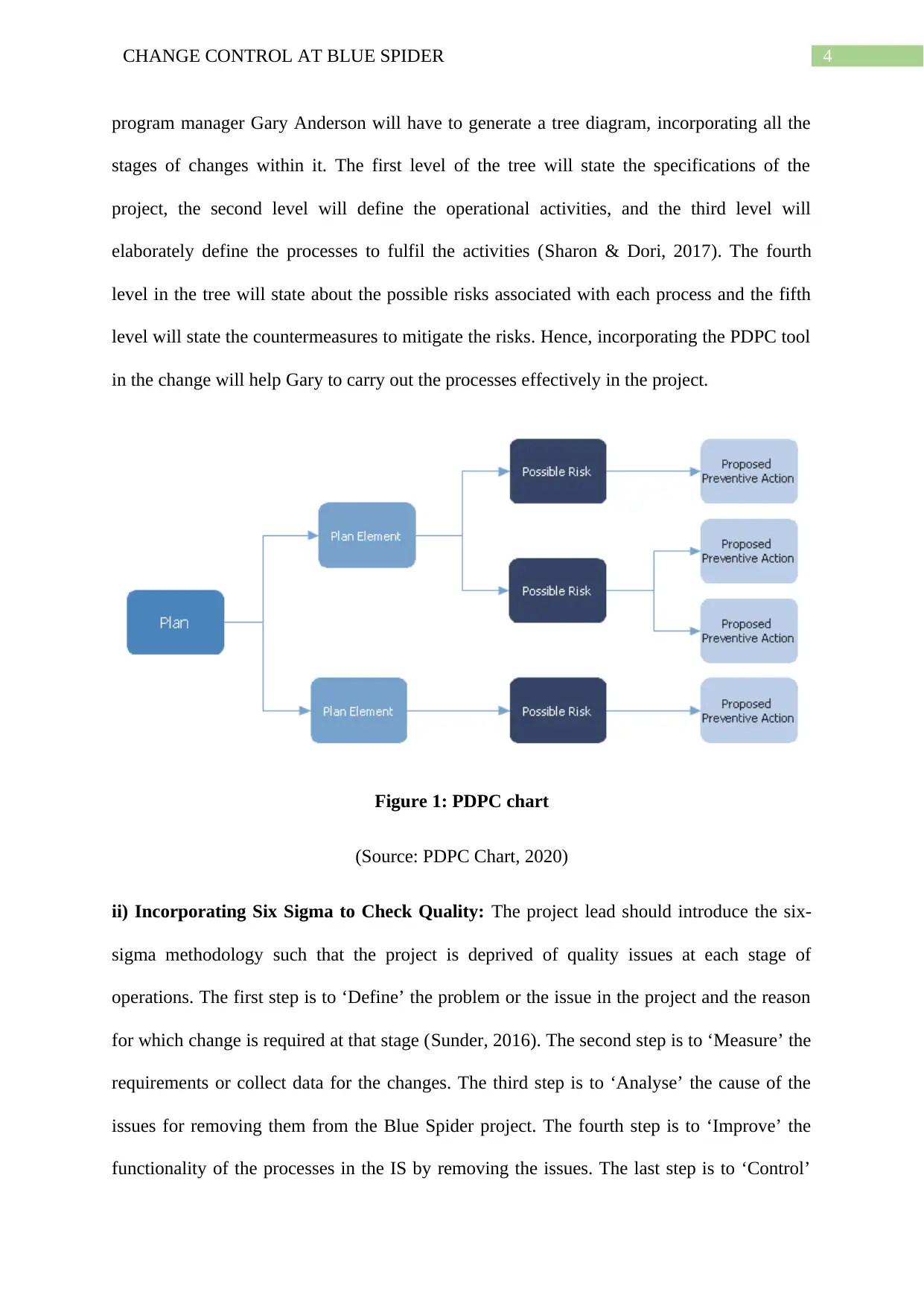
4CHANGE CONTROL AT BLUE SPIDER
program manager Gary Anderson will have to generate a tree diagram, incorporating all the
stages of changes within it. The first level of the tree will state the specifications of the
project, the second level will define the operational activities, and the third level will
elaborately define the processes to fulfil the activities (Sharon & Dori, 2017). The fourth
level in the tree will state about the possible risks associated with each process and the fifth
level will state the countermeasures to mitigate the risks. Hence, incorporating the PDPC tool
in the change will help Gary to carry out the processes effectively in the project.
Figure 1: PDPC chart
(Source: PDPC Chart, 2020)
ii) Incorporating Six Sigma to Check Quality: The project lead should introduce the six-
sigma methodology such that the project is deprived of quality issues at each stage of
operations. The first step is to ‘Define’ the problem or the issue in the project and the reason
for which change is required at that stage (Sunder, 2016). The second step is to ‘Measure’ the
requirements or collect data for the changes. The third step is to ‘Analyse’ the cause of the
issues for removing them from the Blue Spider project. The fourth step is to ‘Improve’ the
functionality of the processes in the IS by removing the issues. The last step is to ‘Control’
program manager Gary Anderson will have to generate a tree diagram, incorporating all the
stages of changes within it. The first level of the tree will state the specifications of the
project, the second level will define the operational activities, and the third level will
elaborately define the processes to fulfil the activities (Sharon & Dori, 2017). The fourth
level in the tree will state about the possible risks associated with each process and the fifth
level will state the countermeasures to mitigate the risks. Hence, incorporating the PDPC tool
in the change will help Gary to carry out the processes effectively in the project.
Figure 1: PDPC chart
(Source: PDPC Chart, 2020)
ii) Incorporating Six Sigma to Check Quality: The project lead should introduce the six-
sigma methodology such that the project is deprived of quality issues at each stage of
operations. The first step is to ‘Define’ the problem or the issue in the project and the reason
for which change is required at that stage (Sunder, 2016). The second step is to ‘Measure’ the
requirements or collect data for the changes. The third step is to ‘Analyse’ the cause of the
issues for removing them from the Blue Spider project. The fourth step is to ‘Improve’ the
functionality of the processes in the IS by removing the issues. The last step is to ‘Control’
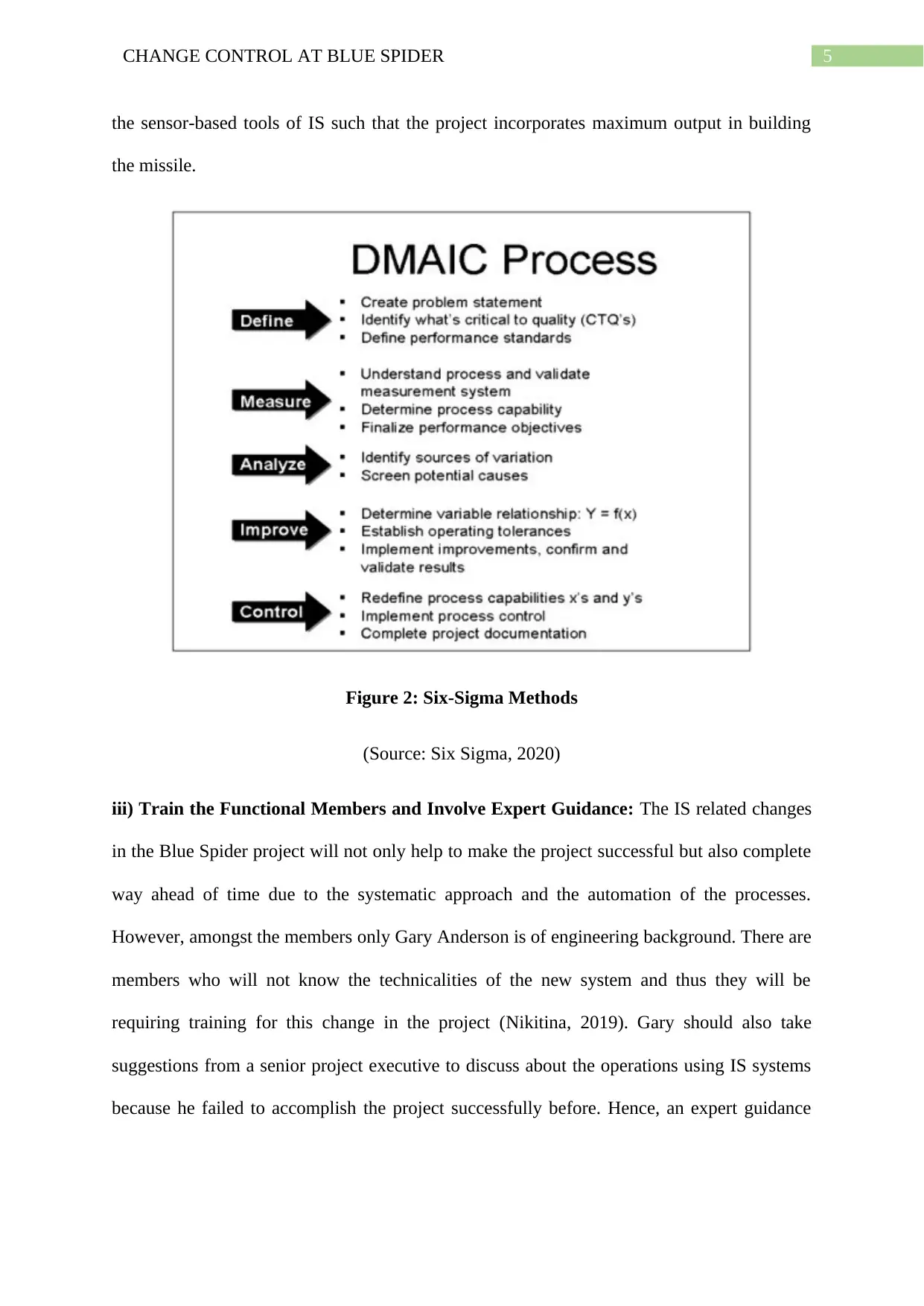
5CHANGE CONTROL AT BLUE SPIDER
the sensor-based tools of IS such that the project incorporates maximum output in building
the missile.
Figure 2: Six-Sigma Methods
(Source: Six Sigma, 2020)
iii) Train the Functional Members and Involve Expert Guidance: The IS related changes
in the Blue Spider project will not only help to make the project successful but also complete
way ahead of time due to the systematic approach and the automation of the processes.
However, amongst the members only Gary Anderson is of engineering background. There are
members who will not know the technicalities of the new system and thus they will be
requiring training for this change in the project (Nikitina, 2019). Gary should also take
suggestions from a senior project executive to discuss about the operations using IS systems
because he failed to accomplish the project successfully before. Hence, an expert guidance
the sensor-based tools of IS such that the project incorporates maximum output in building
the missile.
Figure 2: Six-Sigma Methods
(Source: Six Sigma, 2020)
iii) Train the Functional Members and Involve Expert Guidance: The IS related changes
in the Blue Spider project will not only help to make the project successful but also complete
way ahead of time due to the systematic approach and the automation of the processes.
However, amongst the members only Gary Anderson is of engineering background. There are
members who will not know the technicalities of the new system and thus they will be
requiring training for this change in the project (Nikitina, 2019). Gary should also take
suggestions from a senior project executive to discuss about the operations using IS systems
because he failed to accomplish the project successfully before. Hence, an expert guidance
⊘ This is a preview!⊘
Do you want full access?
Subscribe today to unlock all pages.

Trusted by 1+ million students worldwide
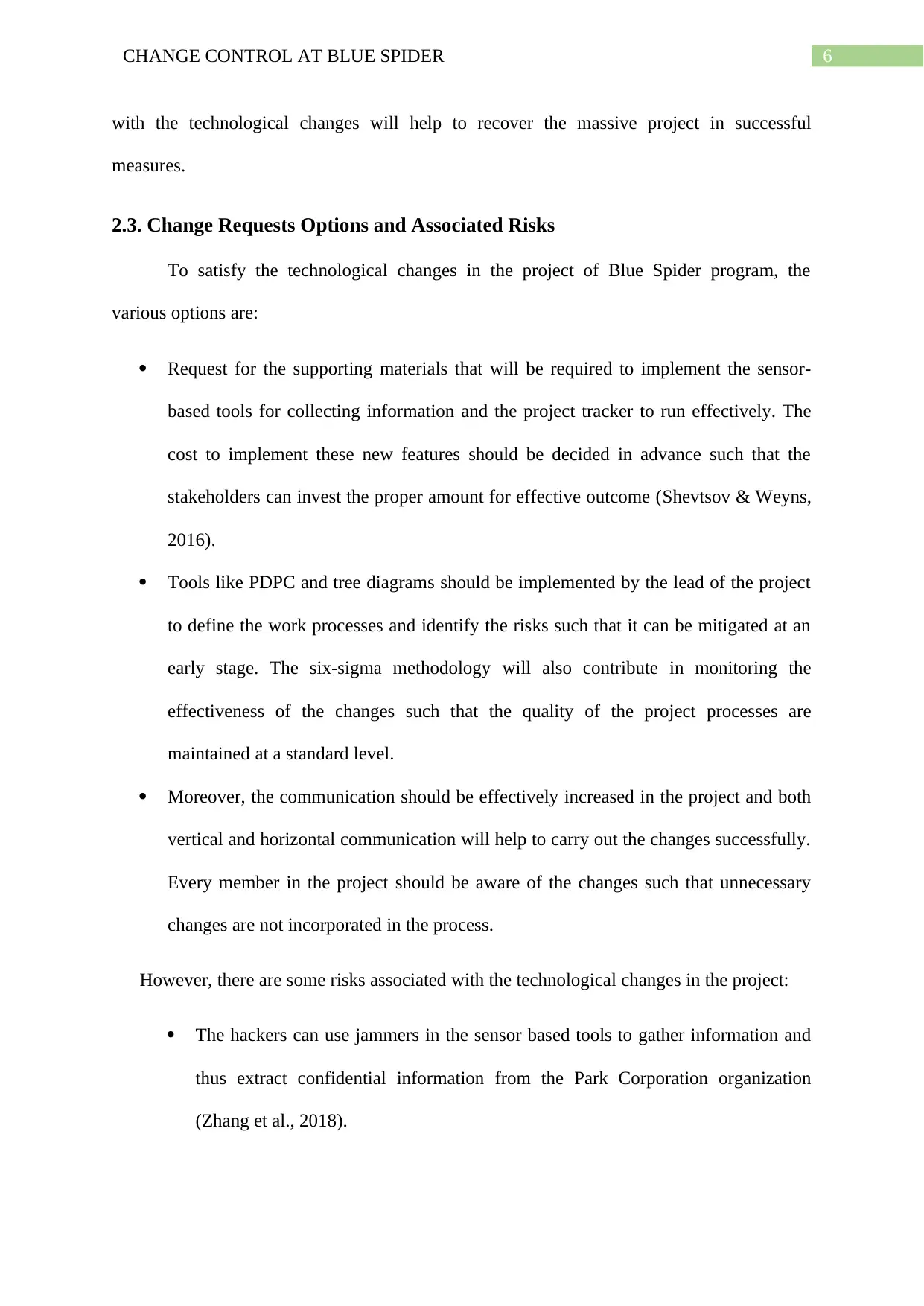
6CHANGE CONTROL AT BLUE SPIDER
with the technological changes will help to recover the massive project in successful
measures.
2.3. Change Requests Options and Associated Risks
To satisfy the technological changes in the project of Blue Spider program, the
various options are:
Request for the supporting materials that will be required to implement the sensor-
based tools for collecting information and the project tracker to run effectively. The
cost to implement these new features should be decided in advance such that the
stakeholders can invest the proper amount for effective outcome (Shevtsov & Weyns,
2016).
Tools like PDPC and tree diagrams should be implemented by the lead of the project
to define the work processes and identify the risks such that it can be mitigated at an
early stage. The six-sigma methodology will also contribute in monitoring the
effectiveness of the changes such that the quality of the project processes are
maintained at a standard level.
Moreover, the communication should be effectively increased in the project and both
vertical and horizontal communication will help to carry out the changes successfully.
Every member in the project should be aware of the changes such that unnecessary
changes are not incorporated in the process.
However, there are some risks associated with the technological changes in the project:
The hackers can use jammers in the sensor based tools to gather information and
thus extract confidential information from the Park Corporation organization
(Zhang et al., 2018).
with the technological changes will help to recover the massive project in successful
measures.
2.3. Change Requests Options and Associated Risks
To satisfy the technological changes in the project of Blue Spider program, the
various options are:
Request for the supporting materials that will be required to implement the sensor-
based tools for collecting information and the project tracker to run effectively. The
cost to implement these new features should be decided in advance such that the
stakeholders can invest the proper amount for effective outcome (Shevtsov & Weyns,
2016).
Tools like PDPC and tree diagrams should be implemented by the lead of the project
to define the work processes and identify the risks such that it can be mitigated at an
early stage. The six-sigma methodology will also contribute in monitoring the
effectiveness of the changes such that the quality of the project processes are
maintained at a standard level.
Moreover, the communication should be effectively increased in the project and both
vertical and horizontal communication will help to carry out the changes successfully.
Every member in the project should be aware of the changes such that unnecessary
changes are not incorporated in the process.
However, there are some risks associated with the technological changes in the project:
The hackers can use jammers in the sensor based tools to gather information and
thus extract confidential information from the Park Corporation organization
(Zhang et al., 2018).
Paraphrase This Document
Need a fresh take? Get an instant paraphrase of this document with our AI Paraphraser
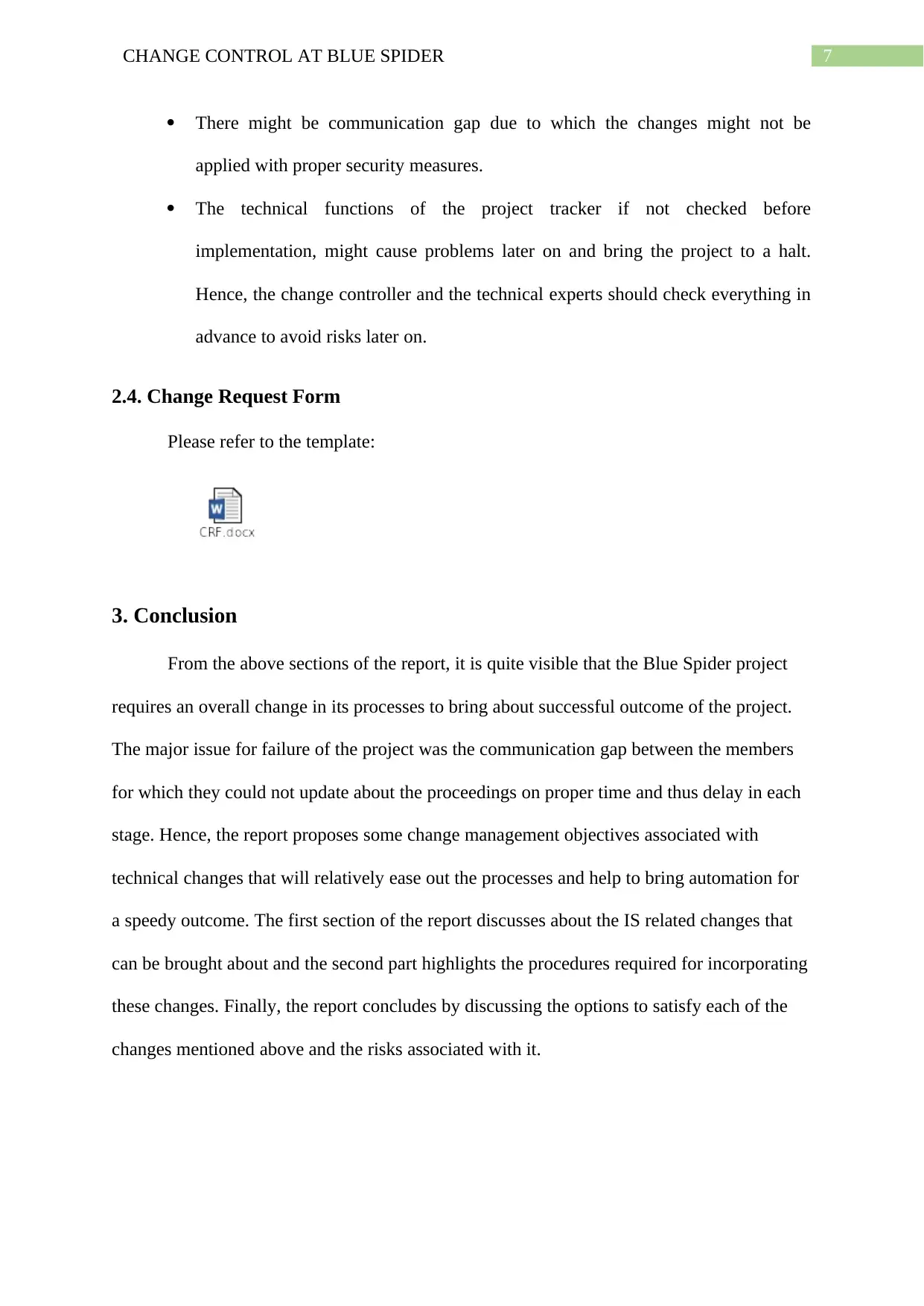
7CHANGE CONTROL AT BLUE SPIDER
There might be communication gap due to which the changes might not be
applied with proper security measures.
The technical functions of the project tracker if not checked before
implementation, might cause problems later on and bring the project to a halt.
Hence, the change controller and the technical experts should check everything in
advance to avoid risks later on.
2.4. Change Request Form
Please refer to the template:
3. Conclusion
From the above sections of the report, it is quite visible that the Blue Spider project
requires an overall change in its processes to bring about successful outcome of the project.
The major issue for failure of the project was the communication gap between the members
for which they could not update about the proceedings on proper time and thus delay in each
stage. Hence, the report proposes some change management objectives associated with
technical changes that will relatively ease out the processes and help to bring automation for
a speedy outcome. The first section of the report discusses about the IS related changes that
can be brought about and the second part highlights the procedures required for incorporating
these changes. Finally, the report concludes by discussing the options to satisfy each of the
changes mentioned above and the risks associated with it.
There might be communication gap due to which the changes might not be
applied with proper security measures.
The technical functions of the project tracker if not checked before
implementation, might cause problems later on and bring the project to a halt.
Hence, the change controller and the technical experts should check everything in
advance to avoid risks later on.
2.4. Change Request Form
Please refer to the template:
3. Conclusion
From the above sections of the report, it is quite visible that the Blue Spider project
requires an overall change in its processes to bring about successful outcome of the project.
The major issue for failure of the project was the communication gap between the members
for which they could not update about the proceedings on proper time and thus delay in each
stage. Hence, the report proposes some change management objectives associated with
technical changes that will relatively ease out the processes and help to bring automation for
a speedy outcome. The first section of the report discusses about the IS related changes that
can be brought about and the second part highlights the procedures required for incorporating
these changes. Finally, the report concludes by discussing the options to satisfy each of the
changes mentioned above and the risks associated with it.
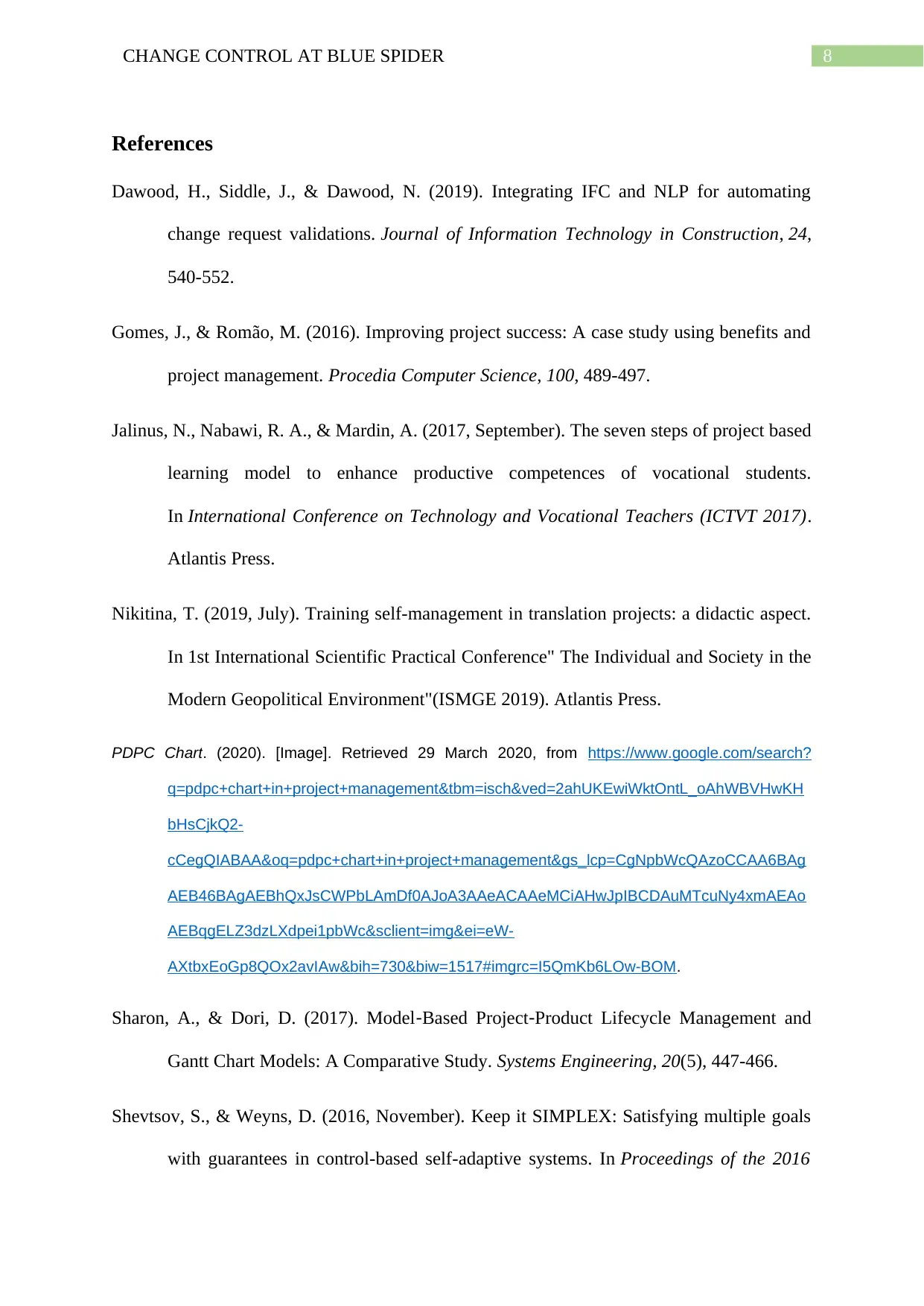
8CHANGE CONTROL AT BLUE SPIDER
References
Dawood, H., Siddle, J., & Dawood, N. (2019). Integrating IFC and NLP for automating
change request validations. Journal of Information Technology in Construction, 24,
540-552.
Gomes, J., & Romão, M. (2016). Improving project success: A case study using benefits and
project management. Procedia Computer Science, 100, 489-497.
Jalinus, N., Nabawi, R. A., & Mardin, A. (2017, September). The seven steps of project based
learning model to enhance productive competences of vocational students.
In International Conference on Technology and Vocational Teachers (ICTVT 2017).
Atlantis Press.
Nikitina, T. (2019, July). Training self-management in translation projects: a didactic aspect.
In 1st International Scientific Practical Conference" The Individual and Society in the
Modern Geopolitical Environment"(ISMGE 2019). Atlantis Press.
PDPC Chart. (2020). [Image]. Retrieved 29 March 2020, from https://www.google.com/search?
q=pdpc+chart+in+project+management&tbm=isch&ved=2ahUKEwiWktOntL_oAhWBVHwKH
bHsCjkQ2-
cCegQIABAA&oq=pdpc+chart+in+project+management&gs_lcp=CgNpbWcQAzoCCAA6BAg
AEB46BAgAEBhQxJsCWPbLAmDf0AJoA3AAeACAAeMCiAHwJpIBCDAuMTcuNy4xmAEAo
AEBqgELZ3dzLXdpei1pbWc&sclient=img&ei=eW-
AXtbxEoGp8QOx2avIAw&bih=730&biw=1517#imgrc=I5QmKb6LOw-BOM.
Sharon, A., & Dori, D. (2017). Model‐Based Project‐Product Lifecycle Management and
Gantt Chart Models: A Comparative Study. Systems Engineering, 20(5), 447-466.
Shevtsov, S., & Weyns, D. (2016, November). Keep it SIMPLEX: Satisfying multiple goals
with guarantees in control-based self-adaptive systems. In Proceedings of the 2016
References
Dawood, H., Siddle, J., & Dawood, N. (2019). Integrating IFC and NLP for automating
change request validations. Journal of Information Technology in Construction, 24,
540-552.
Gomes, J., & Romão, M. (2016). Improving project success: A case study using benefits and
project management. Procedia Computer Science, 100, 489-497.
Jalinus, N., Nabawi, R. A., & Mardin, A. (2017, September). The seven steps of project based
learning model to enhance productive competences of vocational students.
In International Conference on Technology and Vocational Teachers (ICTVT 2017).
Atlantis Press.
Nikitina, T. (2019, July). Training self-management in translation projects: a didactic aspect.
In 1st International Scientific Practical Conference" The Individual and Society in the
Modern Geopolitical Environment"(ISMGE 2019). Atlantis Press.
PDPC Chart. (2020). [Image]. Retrieved 29 March 2020, from https://www.google.com/search?
q=pdpc+chart+in+project+management&tbm=isch&ved=2ahUKEwiWktOntL_oAhWBVHwKH
bHsCjkQ2-
cCegQIABAA&oq=pdpc+chart+in+project+management&gs_lcp=CgNpbWcQAzoCCAA6BAg
AEB46BAgAEBhQxJsCWPbLAmDf0AJoA3AAeACAAeMCiAHwJpIBCDAuMTcuNy4xmAEAo
AEBqgELZ3dzLXdpei1pbWc&sclient=img&ei=eW-
AXtbxEoGp8QOx2avIAw&bih=730&biw=1517#imgrc=I5QmKb6LOw-BOM.
Sharon, A., & Dori, D. (2017). Model‐Based Project‐Product Lifecycle Management and
Gantt Chart Models: A Comparative Study. Systems Engineering, 20(5), 447-466.
Shevtsov, S., & Weyns, D. (2016, November). Keep it SIMPLEX: Satisfying multiple goals
with guarantees in control-based self-adaptive systems. In Proceedings of the 2016
⊘ This is a preview!⊘
Do you want full access?
Subscribe today to unlock all pages.

Trusted by 1+ million students worldwide
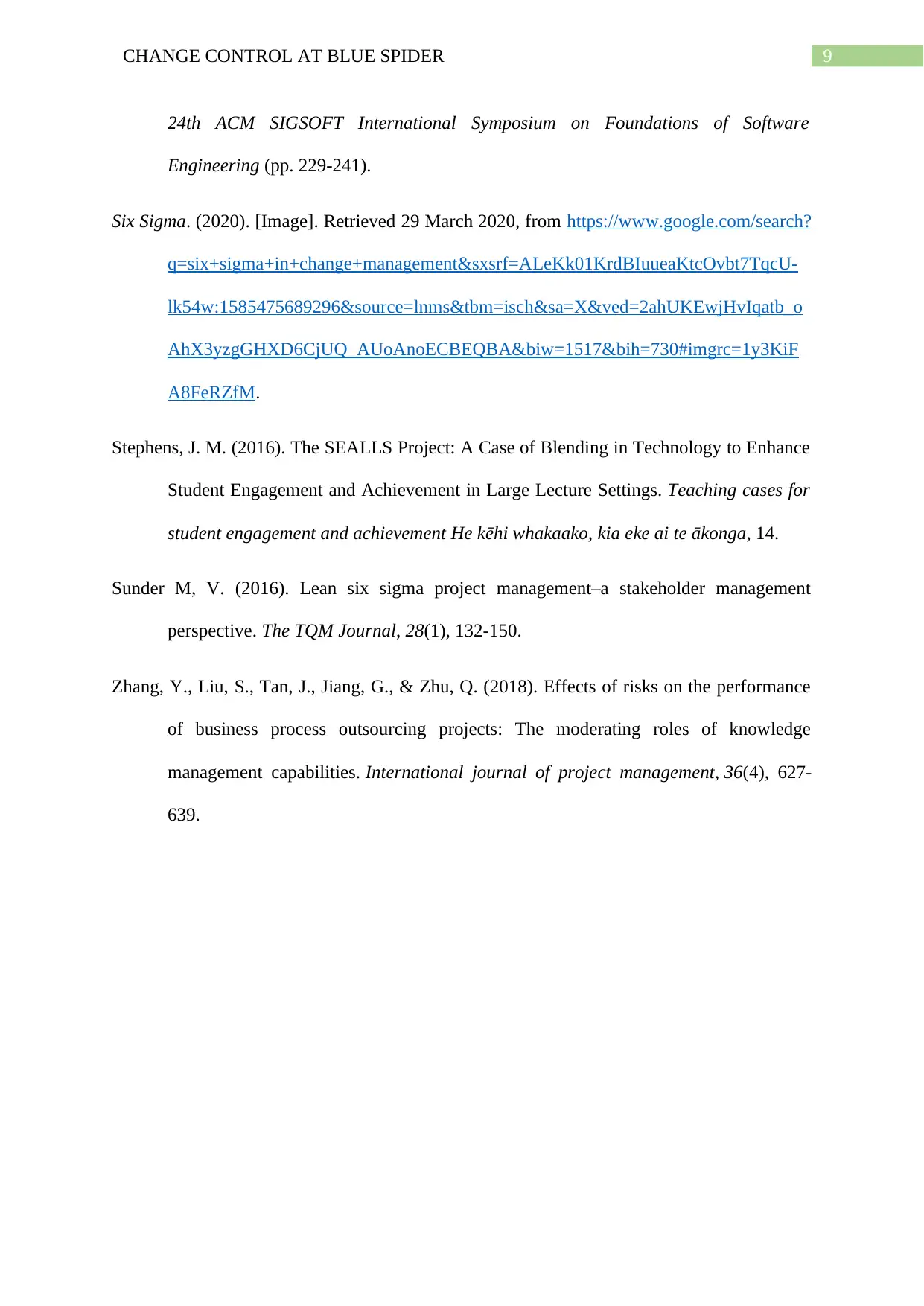
9CHANGE CONTROL AT BLUE SPIDER
24th ACM SIGSOFT International Symposium on Foundations of Software
Engineering (pp. 229-241).
Six Sigma. (2020). [Image]. Retrieved 29 March 2020, from https://www.google.com/search?
q=six+sigma+in+change+management&sxsrf=ALeKk01KrdBIuueaKtcOvbt7TqcU-
lk54w:1585475689296&source=lnms&tbm=isch&sa=X&ved=2ahUKEwjHvIqatb_o
AhX3yzgGHXD6CjUQ_AUoAnoECBEQBA&biw=1517&bih=730#imgrc=1y3KiF
A8FeRZfM.
Stephens, J. M. (2016). The SEALLS Project: A Case of Blending in Technology to Enhance
Student Engagement and Achievement in Large Lecture Settings. Teaching cases for
student engagement and achievement He kēhi whakaako, kia eke ai te ākonga, 14.
Sunder M, V. (2016). Lean six sigma project management–a stakeholder management
perspective. The TQM Journal, 28(1), 132-150.
Zhang, Y., Liu, S., Tan, J., Jiang, G., & Zhu, Q. (2018). Effects of risks on the performance
of business process outsourcing projects: The moderating roles of knowledge
management capabilities. International journal of project management, 36(4), 627-
639.
24th ACM SIGSOFT International Symposium on Foundations of Software
Engineering (pp. 229-241).
Six Sigma. (2020). [Image]. Retrieved 29 March 2020, from https://www.google.com/search?
q=six+sigma+in+change+management&sxsrf=ALeKk01KrdBIuueaKtcOvbt7TqcU-
lk54w:1585475689296&source=lnms&tbm=isch&sa=X&ved=2ahUKEwjHvIqatb_o
AhX3yzgGHXD6CjUQ_AUoAnoECBEQBA&biw=1517&bih=730#imgrc=1y3KiF
A8FeRZfM.
Stephens, J. M. (2016). The SEALLS Project: A Case of Blending in Technology to Enhance
Student Engagement and Achievement in Large Lecture Settings. Teaching cases for
student engagement and achievement He kēhi whakaako, kia eke ai te ākonga, 14.
Sunder M, V. (2016). Lean six sigma project management–a stakeholder management
perspective. The TQM Journal, 28(1), 132-150.
Zhang, Y., Liu, S., Tan, J., Jiang, G., & Zhu, Q. (2018). Effects of risks on the performance
of business process outsourcing projects: The moderating roles of knowledge
management capabilities. International journal of project management, 36(4), 627-
639.
1 out of 10
Related Documents
Your All-in-One AI-Powered Toolkit for Academic Success.
+13062052269
info@desklib.com
Available 24*7 on WhatsApp / Email
![[object Object]](/_next/static/media/star-bottom.7253800d.svg)
Unlock your academic potential
Copyright © 2020–2025 A2Z Services. All Rights Reserved. Developed and managed by ZUCOL.





